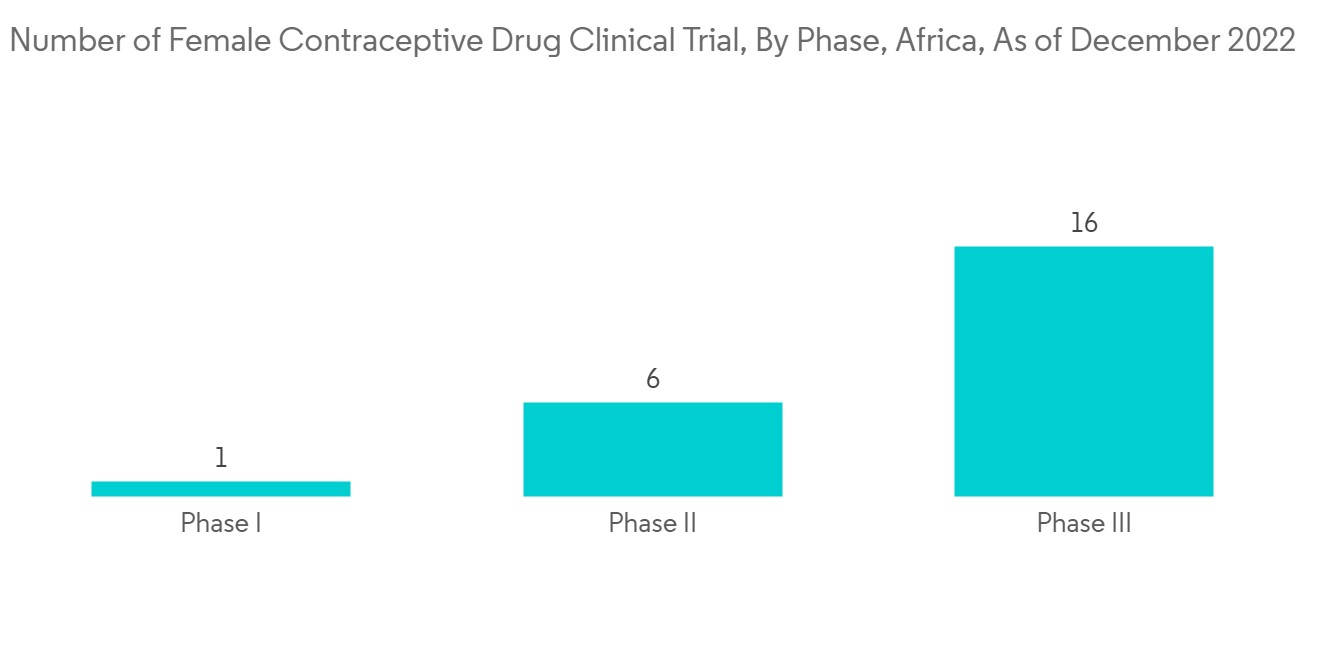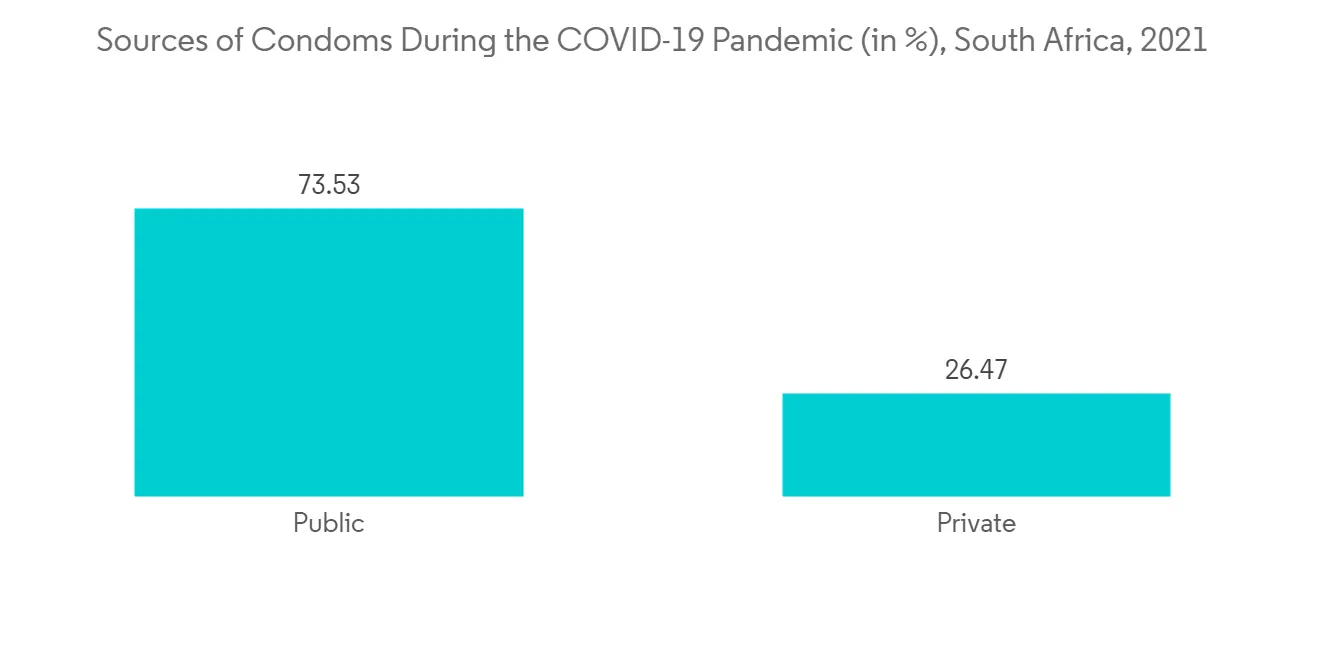PUBLISHER: Mordor Intelligence | PRODUCT CODE: 1272682

PUBLISHER: Mordor Intelligence | PRODUCT CODE: 1272682
Africa Contraceptive Drugs and Devices Market - Growth, Trends, and Forecasts (2023 - 2028)
The African contraceptive drugs and devices market is expected to register a CAGR of 7.2% during the forecast period.
The outbreak of the COVID-19 pandemic has pushed the healthcare industry into action, with a race to develop both therapeutic and preventive drugs. Exponentially increasing cases of the coronavirus worldwide are leading to the need for the development of novel treatments, with several clinical trials underway. Initially, the global COVID-19 outbreak and the lockdown scenario in various countries have imposed some challenges on the market, as hospitals and clinics were forced to suspend services to prevent the spread of the SARS-CoV-2 virus. The restrictions imposed by the government have significantly impacted the growth of the studied market during the initial period of the pandemic. As per the study published in August 2022 by the African Journal of Primary Health Care & Family Medicine, the COVID-19 pandemic aggravated the risk of sub-Saharan African women to HIV infection because of a multitude of factors, including child marriages, teenage pregnancies, dropping out of school, increase in the incidence of sexual and gender-based violence and reduced access to preventive and treatment services for HIV and sexually transmitted infections. In addition, the market growth is stabilizing in the current scenario after COVID-19 as the worldwide restrictions have eased down and various services have been resumed.
Certain factors propelling the market growth are increasing incidences of sexually transmitted diseases, an increasing rate of unintended pregnancies, and rising government initiatives.
An unintended pregnancy occurs from not using contraception or inconsistent and incorrect use of contraceptive methods. The growth of contraceptive markets is necessary to avoid unwanted pregnancies and their complications, especially in teenagers. Teenage pregnancy is a big problem in Africa. For instance, as per the data published by the UNFPA in June 2022, in Southern Africa, 65% of pregnancies were unintended, and 36% ended in abortion. The predominant cause of unintended pregnancy is sexual activity without effective contraception through choice or coercion. In many cases, unintended pregnancy is linked to gender-based violence, including early sexual debut that is non-consensual and child marriage. An increase in unplanned pregnancies has helped in the growth of the market.
In addition, the rising prevalence of sexually transmitted diseases among the population is expected to increase the market growth. For instance, the WHO estimates, updated in July 2021, that sub-Saharan Africa bears approximately 40% of the global burden of STIs. Additionally, as per the study published in April 2021, by BMC Public Health, STI prevalence was 7.7% and did not differ by HIV status. Prevalence differed by syndrome (3.5% vaginal discharge, 1.5% genital ulcer, 2.1% lower abdominal pain, 0.2% inguinal bubo). Thus, the rising burden of sexually transmitted diseases is expected to increase the demand for contraception to avoid getting diseases, thereby propelling market growth.
However, the high cost of devices and treatment and side effects associated with the use of contraceptive drugs and devices are some of the factors that are likely to impede market growth over the forecast period.
Africa Contraceptive Drugs and Devices Market Trends
The Oral Contraceptives Segment is Expected to Show Better Growth in the Forecast Years
Based on drugs, the market is segmented into oral, topical, and contraceptive injectables. Oral contraceptive pills are considered the easiest method of contraception in the industry. They prohibit implantation within the uterus if taken within 2-3 days of unsafe sexual contact. These are easily marketed across large regions by several companies and thus easily consumed by a large population.
According to WHO data updated in June 2021, around 214 million women of reproductive age in developing countries who want to avoid pregnancy are not using a modern contraceptive method. In Africa, 24.2% of women of reproductive age have an unmet need for modern contraception, as per the WHO estimates. Hence, the rising demand for contraceptives to avoid unintended pregnancies and rising government initiatives are expected to drive the market in the forecast period.
Moreover, as per the study published in January 2022 by Contraception and Reproductive Medicine, the awareness of emergency contraceptives among women of reproductive age in South America has increased. South Africa reported the level of emergency contraceptive (EC) awareness to be 57% compared to the previous year. Therefore, the rising awareness among the population about contraceptives is expected to increase the demand for contraceptive pills, which is expected to boost the market's growth over the forecast period.

Condoms Segment is Expected to Show Better Growth in the Forecast Years
Condoms are a "barrier" method of contraception. They are made of very thin latex (rubber), polyurethane, or polyisoprene and are designed to prevent pregnancy by stopping sperm from meeting an egg. They can also protect against STIs if used correctly during vaginal, anal, and oral sex.
As per the data updated in June 2021 by population.un.org, in 2021, nearly 51 percent of women aged 15-49 years in Southern Africa used contraceptives - either traditional or modern methods. The region registered the highest contraceptive prevalence rate in Africa. On the other hand, only 20% of fertile-age women in Western Africa adopted any form of contraception. East Africa registered the largest improvement in the continent during the period under study. Thus, the increasing usage of contraceptives is expected to increase the demand for condoms in Africa which is further expected to boost the growth of the market over the forecast period.
Moreover, as per the data updated in June 2022, by Statistics South Africa, as of 2021, approximately three percent of females aged 14 to 19 years in South Africa stated that they were going through different stages of pregnancy within the last 12 months. The prevalence of pregnancy increased with age. While zero percent of young women aged 14 stated that they were pregnant, the number of 19-year-old pregnant women was nearly seven percent. Furthermore, pregnancy in the age group 14-19 years dropped significantly in 2021 compared to the previous years. Thus, the rising number of unintended pregnancies is expected to boost the demand for condoms which in turn is anticipated to boost the market growth over the forecast period.

Africa Contraceptive Drugs and Devices Industry Overview
Africa's Contraceptive Drug and Devices Market is moderately competitive, and several local and international companies deal with contraceptives. The major players in the Africa contraceptive drugs and devices market are Allergan PLC, Bayer AG, Johnson & Johnson, Lupin Limited, Merck & Co. Inc., Mylan NV, Pfizer Inc., and Teva Pharmaceutical Industries Ltd.
Additional Benefits:
- The market estimate (ME) sheet in Excel format
- 3 months of analyst support
TABLE OF CONTENTS
1 INTRODUCTION
- 1.1 Study Assumptions and Market Definition
- 1.2 Scope of the Study
2 RESEARCH METHODOLOGY
3 EXECUTIVE SUMMARY
4 MARKET DYNAMICS
- 4.1 Market Overview
- 4.2 Market Drivers
- 4.2.1 Increasing Incidence of the STDs and Unplanned Pregnancies
- 4.2.2 Rise in Government Initiatives
- 4.3 Market Restraints
- 4.3.1 Side Effects Associated with the Use of Contraceptive Drugs and Devices
- 4.4 Porter's Five Forces Analysis
- 4.4.1 Threat of New Entrants
- 4.4.2 Bargaining Power of Buyers/Consumers
- 4.4.3 Bargaining Power of Suppliers
- 4.4.4 Threat of Substitute Products
- 4.4.5 Intensity of Competitive Rivalry
5 MARKET SEGMENTATION (Market Size by Value in USD million)
- 5.1 By Products
- 5.1.1 By Drugs
- 5.1.1.1 Oral Contraceptives
- 5.1.1.2 Topical Contraceptives
- 5.1.1.3 Contraceptive Injectable
- 5.1.2 By Device
- 5.1.2.1 Condoms
- 5.1.2.2 Diaphragms
- 5.1.2.3 Cervical Caps
- 5.1.2.4 Sponges
- 5.1.2.5 Vaginal Rings
- 5.1.2.6 IUD
- 5.1.2.7 Other Devices
- 5.1.1 By Drugs
- 5.2 By Gender
- 5.2.1 Male
- 5.2.2 Female
6 COMPETITIVE LANDSCAPE
- 6.1 Company Profiles
- 6.1.1 AbbVie
- 6.1.2 Bayer AG
- 6.1.3 Johnson & Johnson
- 6.1.4 Lupin Limited
- 6.1.5 Merck & Co. Inc.
- 6.1.6 Mylan N.V.
- 6.1.7 Pfizer Inc.
- 6.1.8 Teva Pharmaceutical Industries Ltd
7 MARKET OPPORTUNITIES AND FUTURE TRENDS




